
HOME / Departments / Physics / Solid State Physics
Solid State Physics
-
- KIMURA Takashi, Professor
- IIMORI Riku, Assistant Professor
- ARAI Takeshi, Research Associate
- We are interested in electron-transport phenomena in nano-scale systems composed of different types of functional materials such as ferro- and antiferro-magnetic materials, superconductor, normal metal and insulator. Especially, we focus significantly on the influence of electron spin in the transports, so called spin-dependent transports. Moreover, understanding and manipulating the dynamical motions of spin is also important research subject. The specific example of the research subject is as follows.
- Understanding electrically and thermally driven spin-current transports
- Interplay between spin-polarized electron and cooper pair
- Nonlinear motion of nano-scale spin dynamics in patterned ferromagnetic film
- Development of novel nanoelectric devices such as spin memristor and spin filter
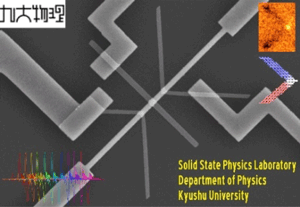
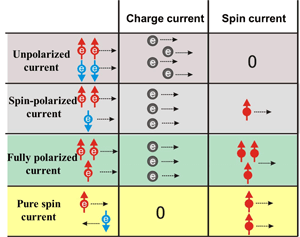
Manifestation of the conduction electrons in a solid state is one of the most important aspects for the electrical transports in the condensed matter physics. The strong correlation between the electron transport properties and the electron spin, namely spin-dependent transports, has received the considerable attentions after the discovery of giant magneto-resistance effect. Owing to the developments of the theoretical understanding and experimental techniques, the spin current, which is a flow of the spin angular momentum, is found to play the central role for the electron transports in ferromagnetic/nonmagnetic hybrid nanostructures. Especially, a pure spin current, which is a spin current without accompanying the charge current(Table1), enables the precise and sensitive detection of the spin-related phenomena such as spin Hall and spin Seebeck effects. Moreover, the injection of the spin current into another ferromagnet transfers the spin angular momentum, resulting in the magnetization reversal of the ferromagnet. Thus, spin currents are very attractive both from a fundamental and a technological point of view.
1a. Electrically excited pure spin current [1]
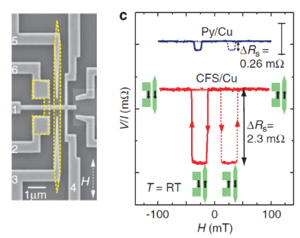
We have developed the methods for the efficient generation, manipulation and detection of the pure spin current in laterally configured ferromagnetic/nonmagnetic metal hybrid structures. We mainly investigate the diffusive transport properties of the pure spin current induced in the ferromagnetic/nonmagnetic-metal hybrid nanostructures(Fig 2). We are also interested in the spin transfer torque induced by pure spin current injection. We try to demonstrate the switching and the steady state oscillation of the magnetization due to the pure spin current injection
1b. Thermally excited pure spin current [2]
Thermal spin injection is also an innovative method for simplifying device integration without the need for electricity, namely wireless spintronics. We have recently demonstrated that a highly spin-polarized, ferromagnetic CoFeAl electrode with a favorable band structure has excellent properties for thermal spin injection (Fig. 3). We will explore an excellent material for efficient thermal spin injection and develop novel spintronic device based on the efficient thermal spin injection. Since the electrical wiring to the individual electrode is an important milestone for integrating the nanoelectric devices, This innovative demonstration based on the efficient thermal spin injection may open a new route for spin-device integration and its applications.
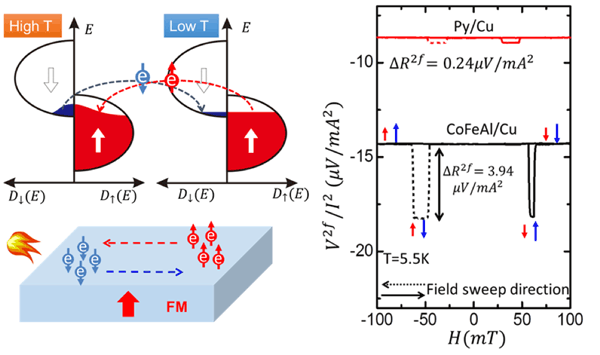
2. Pure spin current transports in the vicinity of the superconductor surface [3]
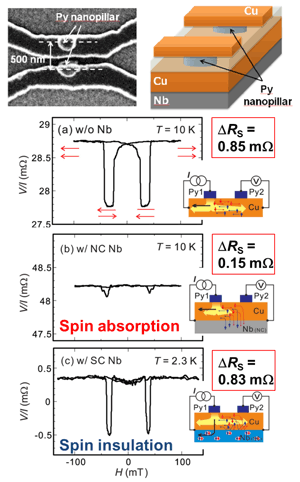
The combination between the spin-dependent and super-conducting (SC) transports is expected to provide intriguing properties such as crossed Andreev reflection and spin-triplet superconductivity. This may be able to open a new avenue in the field of spintronics, namely superconducting spintronics because a superconductor itself has great potential for future nanoelectronic applications. To observe such SC spin transports, the suppression of the extrinsic effects originating from the heating and Oersted field due to the electric current is a crucial role. Pure spin current without accompanying the charge current is known as a powerful mean for preventing such extrinsic effects. However, non-negligible heat flow is found to exist even in a conventional pure spin current device based on laterally-configured spin valve because of the heating around the spin injector. We have developed a nanopillar-based lateral spin valve, which significantly reduces the heat generation, on a superconducting Nb film. By using this ideal platform, we found that the spin absorption is strongly suppressed by the SC transition of Nb. This demonstration is the clear evidence that the super-conducting Nb is an insulator for the pure spin current. (Fig. 4)
3. Magnetic vortex dynamics confined in a triangular ferromagnetic nanodot [4]
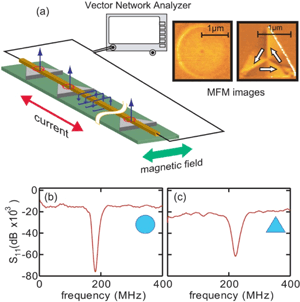
A magnetic vortex structure stabilized in a micron or nano-sized ferromagnetic disk has a strong potential as a unit cell for spin-based nano-electronic devices because of negligible magnetostatic interaction and superior thermal stability. Moreover, various intriguing fundamental physics such as bloch point reversal and symmetry breaking can be induced in the dynamical behaviors in the magnetic vortex. The static and dynamic properties of the magnetic vortex can be tuned by the disk dimension and/or the separation distance between the disks. However, to realize these modifications, the preparations of other devices with different sample geometries are required. We have experimentally demonstrated that, in a regular-triangle Permalloy dot, the dynamic properties of a magnetic vortex are greatly modified by the application of the in-plane magnetic field. The obtained wide range tunability based on the asymmetric position dependence of the core potential provides attractive performances in the microwave spintronic devices.(Fig. 5)
4. Spin memristor operated by electrical spin injection into magnetic insulator [5]
We have developed a fabrication process for a laterally configured resistive switching device based on a Gd oxide. A nano-gap electrode connected by a Gd oxide with the ideal interfaces has been created by adapting the electro-migration method in a metal/GdOx bilayer system. Bipolar set and reset operations have been clearly observed in the Pt/GdOx system similarly in the vertical device based on GdOx. Interestingly, we were able to observe a clear bipolar switching also in a ferromagnetic CoFeB nano-gap electrode with better stability compared to the Pt/GdOx device. The superior performance of the CoFeB/GdOx device implies the importance of the spin on the resistive switching. (Fig. 6)
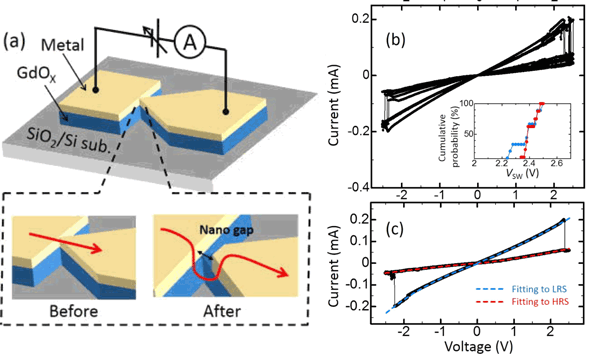
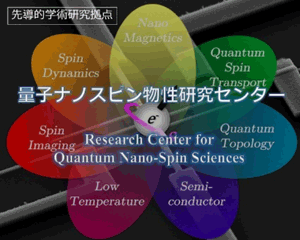
- Handbook of Spintronics, (2014). doi : 10.1007/978-94-007-7604-3_55-1
- NPG Asia Materials (2014) 6, e127; doi:10.1038/am.2014.74
- Scientific Reports 4, 6260 (2014) doi:10.1038/srep06260
- Scientific Reports 3, 3567 (2013) doi:10.1038/srep03567
- Appl. Phys. Lett. 108, 023101 (2016); http://dx.doi.org/10.1063/1.4939683
Research center for quantum nano-spin science has been established in 2014 in order to rapidly develop the core-research for spin-related physics.